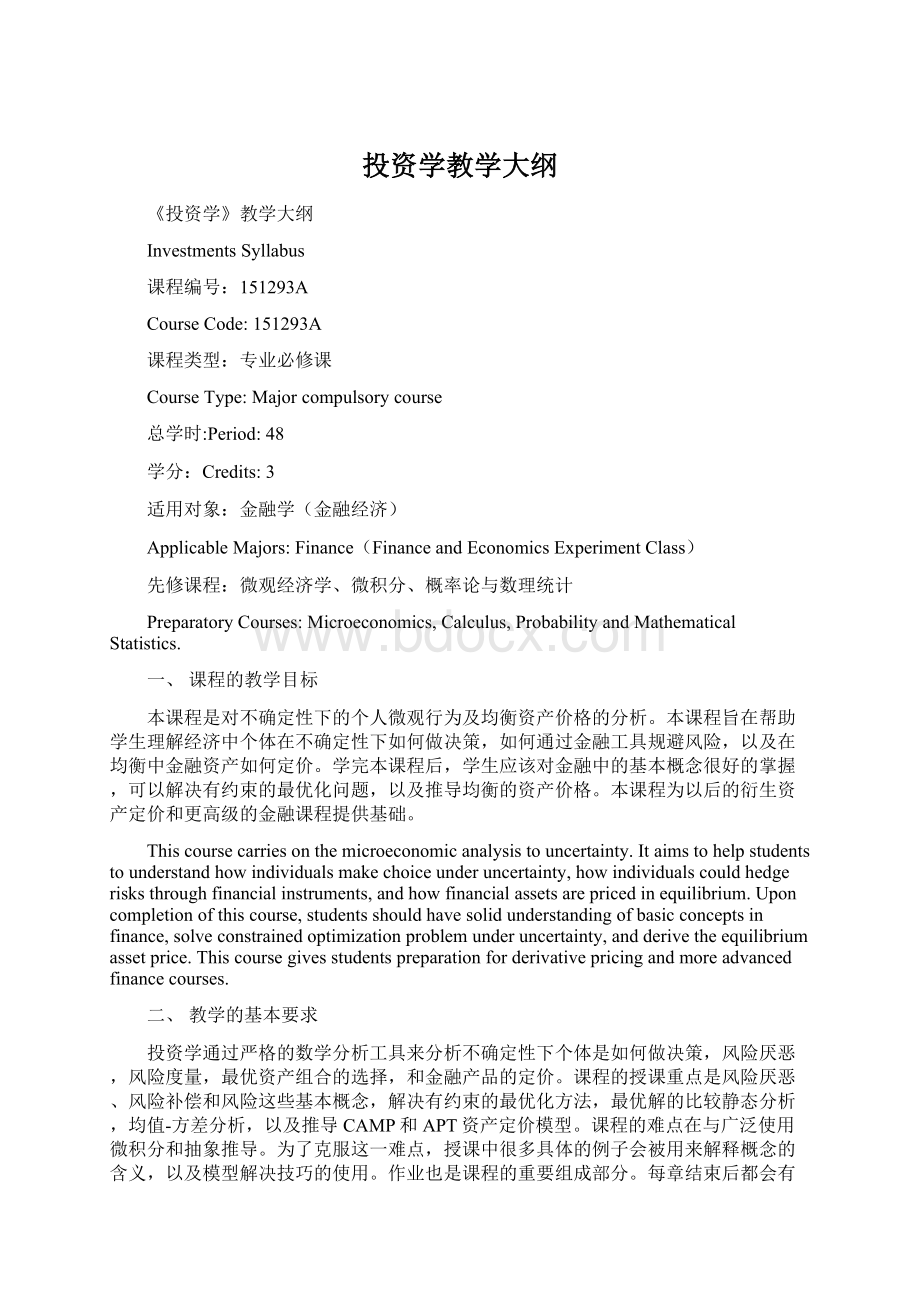投资学教学大纲.docx
《投资学教学大纲.docx》由会员分享,可在线阅读,更多相关《投资学教学大纲.docx(8页珍藏版)》请在冰豆网上搜索。

投资学教学大纲
《投资学》教学大纲
InvestmentsSyllabus
课程编号:
151293A
CourseCode:
151293A
课程类型:
专业必修课
CourseType:
Majorcompulsorycourse
总学时:
Period:
48
学分:
Credits:
3
适用对象:
金融学(金融经济)
ApplicableMajors:
Finance(FinanceandEconomicsExperimentClass)
先修课程:
微观经济学、微积分、概率论与数理统计
PreparatoryCourses:
Microeconomics,Calculus,ProbabilityandMathematicalStatistics.
一、课程的教学目标
本课程是对不确定性下的个人微观行为及均衡资产价格的分析。
本课程旨在帮助学生理解经济中个体在不确定性下如何做决策,如何通过金融工具规避风险,以及在均衡中金融资产如何定价。
学完本课程后,学生应该对金融中的基本概念很好的掌握,可以解决有约束的最优化问题,以及推导均衡的资产价格。
本课程为以后的衍生资产定价和更高级的金融课程提供基础。
Thiscoursecarriesonthemicroeconomicanalysistouncertainty.Itaimstohelpstudentstounderstandhowindividualsmakechoiceunderuncertainty,howindividualscouldhedgerisksthroughfinancialinstruments,andhowfinancialassetsarepricedinequilibrium.Uponcompletionofthiscourse,studentsshouldhavesolidunderstandingofbasicconceptsinfinance,solveconstrainedoptimizationproblemunderuncertainty,andderivetheequilibriumassetprice.Thiscoursegivesstudentspreparationforderivativepricingandmoreadvancedfinancecourses.
二、教学的基本要求
投资学通过严格的数学分析工具来分析不确定性下个体是如何做决策,风险厌恶,风险度量,最优资产组合的选择,和金融产品的定价。
课程的授课重点是风险厌恶、风险补偿和风险这些基本概念,解决有约束的最优化方法,最优解的比较静态分析,均值-方差分析,以及推导CAMP和APT资产定价模型。
课程的难点在与广泛使用微积分和抽象推导。
为了克服这一难点,授课中很多具体的例子会被用来解释概念的含义,以及模型解决技巧的使用。
作业也是课程的重要组成部分。
每章结束后都会有一次作业,作业分组完成,鼓励组内学生的探讨与交流。
作业的设计主要考虑到与教课内容的互补,包括具体实例的计算和一些证明。
课程考核由三部分组成,分别是平时作业16%,期中闭卷考试24%,期末闭卷考试60%。
Thiscourseprovidesanalyticaltoolstomodelindividualdecisionmakingunderuncertainty,riskaversion,measurementofrisk,optimalportfoliochoiceandassetpricing.Theemphaseswillbeonconceptsofriskaversion,riskcompensation,andrisk,andonthetechniquestosolveoptimalportfolio,todocomparativestatics,toderiveCapitalAssetPricingModelandArbitragePricingTheory.Onepotentialchallengeofthiscourseistheextensiveuseofcalculusandabstractreasoning.However,manyconcreteexampleswillbeprovidedtoillustratetheintuitionofbasicconceptsandhowtoapplytechniquestosolveamodel.Homeworkrepresentsanimportantpartofthiscourse.Eachchapterwillbefollowedbyonehomework,whichwillbedonebygroups.Homeworkisdesignedtocomplementlecturenotes,includingcalculationofconcreteexamplesandproofofsomestatementsinlecturenotes.Thegradesincludethreeparts,homework,midtermexam,finalexam.Homeworkcountsfor16%ofthefinalgrade,midtermexamcountsfor24%ofthefinalgrade,andfinalexamcountsfor60%ofthefinalgrade.
三、各教学环节学时分配
教学课时分配
序号
章节内容
讲课
实验
其他
合计
1
期望效用理论
ExpectedUtilityTheory
3
Homework1
2
风险厌恶
RiskAversion
6
Homework2
3
风险
Risk
6
Homework3
4
预算约束
BudgetConstraint
3
Homework4
5
一个风险资产的最优资产组合
OptimalPortfoliowithoneriskyasset
6
Homework5
6
多个风险资产的最优资产组合
OptimalPortfoliowithmanyriskyassets
6
Homework6
7
均值-方差投资分析
Mean-VariancePortfolioAnalysis
6
Homework7
8
资本资产定价模型
CapitalAssetPricingModel
6
Homework8
9
套利定价模型
ArbitragePricingTheory
6
Homework9
合计
48
四、教学内容
第一章期望效用理论
CHAPTERI:
Expectedutilitytheory
第一节消费者效用理论
PART1BasicPreferenceTheory
第二节期望效用理论
PART2ExpectedUtilityTheory
教学重点、难点:
偏好的效用函数表示,和期望效用的计算。
KeyPoints:
utilityfunctionrepresentationofpreferences,andcalculationofexpectedutilityforalottery.
课程的考核要求:
理解什么条件下偏好存在效用函数表示,掌握期望效用的计算。
Requirement:
understandwhenapreferencecanberepresentedbyautilityfunction,masterthecalculationofexpectedutilityforalottery.
第二章:
风险厌恶
CHAPTER2:
Riskaversion
第一节风险厌恶定义
PART1Definitionofriskaversion
第二节风险厌恶与效用函数凹性
PART2Riskaversionandconcavityofutilityfunction
第三节风险厌恶与风险补偿
PART3Riskaversionandriskcompensation
第四节风险厌恶的比较
PART4Comparativeriskaversion
第五节经典效用函数
PART5Classicalutilityfunctions
教学重点、难点:
不同风险度量的含义及其之间的等价,风险厌恶指数的计算。
KeyPoints:
differentmeasuresofriskaversionandtheirequivalence,computationofthecorrespondingriskaversiongivenautilityfunction.
课程的考核要求:
理解不同风险度量的含义及其之间的等价,掌握风险厌恶的定义和风险厌恶指数的计算。
Requirement:
understanddifferentmeasuresriskaversionandtheirequivalence,masterthedefinitionofriskaversionandthecalculationofriskaversionindex.
第三章风险
CHAPTER3Risk
第一节风险定义
PART1DefinitionofRisk
第二节风险与风险厌恶
PART2Riskandriskaversion
第三节风险与方差
PART3Riskandvariance
教学重点、难点:
风险的定义,风险与风险厌恶的关系,风险与方差的区别。
KeyPoints:
thedefinitionofrisk,itsrelationwithriskaversion,anditsdifferencefromvariance.
课程的考核要求:
理解风险与风险厌恶的关系,掌握风险的定义及其与方差的区别。
Requirement:
understandtherelationbetweenriskandwithriskaversion,masterthedefinitionofrisk,anditsdifferencefromvariance.
第四章预算约束
CHAPTER4Budgetconstraint
第一节资产
PART1Assets
第二节无套利价格
PART2Nonarbitrageprices
第三节投资组合限制
PART3Portfoliorestrictions
教学重点、难点:
资产的数学表示,无套利含义。
KeyPoints:
therepresentationofanasset,thedefinitionofnonarbitrage.
课程的考核要求:
理解资产的表示,掌握无套利的定义。
Requirement:
understandtherepresentationofanasset,masterthedefinitionofnonarbitrage.
第五章一个风险资产的最优投资组合
CHAPTER5Optimalportfoliowithoneriskyasset
第一节投资组合问题
PART1Portfoliochoiceproblem
第二节最优投资组合
PART2Optimalportfolio
第三节风险溢价最优投资组合
PART3Riskpremiumandoptimalportfolio
第四节最优投资组合比较静态分析
PART4Comparativestaticsofoptimalportfolio
教学重点、难点:
求解只有一个风险资产时的最优投资组合,以及最优投资组合的比较静态分析。
KeyPoints:
solvetheoptimalportfolio,anditscomparativestatics.
课程的考核要求:
熟练掌握求解只有一个风险资产时的最优投资组合,以及最优投资组合的比较静态分析。
Requirement:
masterhowtosolvetheoptimalportfolio,anditscomparativestatics.
第六章多个风险资产的最优投资组合
CHAPTER6Optimalportfoliowithmanyriskyassets
第一节最优投资组合
PART1Optimalportfolio
第二节风险与收益的权衡
PART2Risk-returntrade-off
第三节公平定价下的最优投资组合
PART3Optimalportfoliounderfairpricing
第四节风险溢价与最优投资组合
PART4Riskpremiumandoptimalportfolio
第五节线性风险承受下的最优投资组合
PART5Optimalportfoliounderlinearrisktolerance
教学重点、难点:
风险与收益的权衡,线性风险承受下的最优投资组合。
KeyPoints:
thetrade-offbetweenriskandreturn,andcalculationoftheoptimalportfoliounderlinearrisktolerance.
课程的考核要求:
理解风险与收益的权衡,掌握线性风险承受下的最优投资组合。
Requirement:
understandthetrade-offbetweenriskandreturn,andmasterthecalculationoftheoptimalportfoliounderlinearrisktolerance.
第七章期望-方差投资分析
CHAPTER7Mean-varianceportfolioanalyses
第一节期望-方差分析与期望效用
PART1:
Consistencyofmean-varianceanalysiswithexpectedutility
第二节标准均值-方差投资问题
PART2:
Standardmean-varianceportfolioproblem
教学重点、难点:
期望-方差分析与期望效用分析的关系,均值-方差最优投资组合。
KeyPoints:
relationbetweenmean-varianceanalysisandexpectedutilityanalysis,calculationoftheoptimalmean-varianceportfolio.
课程的考核要求:
理解期望-方差分析与期望效用分析的关系,掌握均值-方差最优投资组合的推导。
Requirement:
understandtherelationbetweenmean-varianceanalysisandexpectedutilityanalysis,masterthederivationoftheoptimalmean-varianceportfolio.
第八章资本资产定价模型
CHAPTER8ConsumptionAssetPricingModel
第一节证券市场线
PART1:
Securitymarketline
第二节均值-方差偏好下的均衡投资组合
PART2:
Equilibriumportfolioundermean-variancepreference
第三节二次项函数
PART3:
Quadraticutility
第四节正态分布的收益
PART4:
Normallydistributedpayoffs
教学重点、难点:
资产风险溢价及此资产收益与其市场收益协方差之间的关系。
KeyPoints:
therelationbetweentheriskpremiumonanyassetandthecovariancebetweenthereturntothatassetandthemarketreturn.
课程的考核要求:
掌握资产风险溢价及此资产收益与其市场收益协方差之间的关系。
Requirement:
mastertherelationbetweentheriskpremiumonanyassetandthecovariancebetweenthereturntothatassetandthemarketreturn.
第九章套利定价理论
CHAPTER9ArbitragePricingTheory
第一节无误差因子定价
PART1:
Exactfactorpricing
第二节无误差定价,beta定价和CAPM
PART2:
Exactfactorpricing,betapricingandtheCAPM
第三节因子定价误差
PART3:
Factorpricingerrors
第四节因子结构
PART4:
Factorstructure
教学重点、难点:
资产风险溢价及此资产收益对因子风险敏感度之间的关系。
KeyPoints:
therelationbetweentheexpectedreturnonanyassetandthemeasureofthesensitivityofanasset’sreturntofactorrisk.
课程的考核要求:
掌握资产风险溢价及此资产收益对因子风险敏感度之间的关系。
Requirement:
mastertherelationbetweentheexpectedreturnonanyassetandthemeasureofthesensitivityofanasset’sreturntofactorrisk.
五、主要参考书Textbooks
1.Bodie,KaneandMarcus.Investments.McGrawHill.10e.2014
2.LeroyandWerner.Principlesoffinancialeconomics.CambridgeUniversityPress.2001